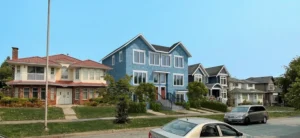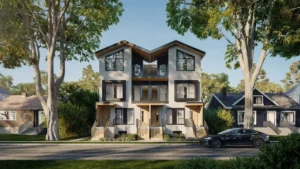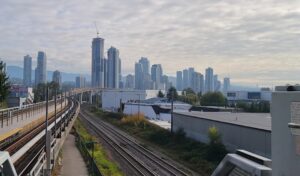Stay in the know
Sign up today for our newsletter, stay up to date on all the latest news in the real estate industry, and get access to exclusive listings and off-market properties.

Big housing changes are underway in BC with the passing of Bill 44 at the end of last year. This legislation aims to streamline the process for individuals and home builders to develop small-scale, multi-unit dwellings that integrate seamlessly into established neighborhoods.
As part of work underway to deliver more homes for people faster, the Province has introduced new legislation to reduce construction delays and streamline processes to fund key services, infrastructure and amenities for growing communities.
“As we take decisive action to deliver the kinds of homes people in B.C. are looking for, we’re also making sure communities and builders have the efficient and transparent tools they need to plan for growth with certainty,” said Ravi Kahlon, Minister of Housing. “By doing this, we’re not just building homes for people, but also more sustainable, well-planned communities.”
 Image-Nora development in Vancouver by Fastmark
Image-Nora development in Vancouver by Fastmark
These details were sourced directly from the gov.bc.ca website:
Small-scale, multi-unit housing describes a range of buildings and housing units that can provide attainable housing for middle-income families. Examples of small-scale, multi-unit housing include:
Enabling small-scale, multi-unit housing
Small-scale, multi-unit housing offers housing options that are ground-oriented and compatible in scale and form within established single-family neighbourhoods. These housing forms typically offer more family-oriented units than larger-scale multi-family housing and more affordable options than single-family dwellings.
While the legislation establishes the framework for the new rules, the details describing how these changes work on the ground are set out in regulation, and site standards and expectations around development are laid out in a Provincial policy manual.
Provincial manual-
Provincial policy manual (PDF, 3.3MB)
Local governments must update their bylaws by June 30, 2024 to accommodate small-scale, multi-unit housing requirements (except in areas where they have applied for an extension).
The small-scale, multi-unit housing changes include:
Housing Needs Reports, Official Community Plans, zoning bylaws, and public hearings
B.C. is shifting to a more pro-active, long-term approach to planning, where local governments identify their housing needs, and then zone for what is needed. New requirements include:
1. All local governments
Update Housing Needs Reports using a standard method on a regular basis for a more consistent, robust understanding of local housing needs over 20 years. Interim Housing Needs Reports must be completed by January 1, 2025.
2. Municipalities
Plan for these needs in Official Community Plans on a regular basis. Municipalities must have completed their first review and update of their Official Community Plans based on the interim Housing Needs Report by December 31, 2025.
3. Municipalities
Align zoning bylaws with the Official Community Plans and Housing Needs Report to pre-zone for the total amount of housing their communities need on a regular basis. Municipalities must have completed their first update of their zoning bylaws to align with their Official Community Plans by December 31, 2025.
Timeline

Another crucial legislative development is Bill 47 poised to reshape the landscape of areas proximate to transit infrastructure. By incentivizing the creation of housing options near transit hubs, it not only promotes efficient mobility but also facilitates the creation of vibrant, transit-oriented communities.
These details were sourced directly from the gov.bc.ca website:
Transit oriented development areas
Last updated on March 8, 2024
Transit Oriented Development (TOD) is an approach to land use planning that locates high-density, mixed-use development within walking distance from frequent transit services. TOD typically incorporates a variety of land uses, including residential, commercial (such as, grocery stores and retail) and community amenities (such as childcare and community centres). TOD promotes the creation of complete, liveable, and sustainable communities by building more homes near transit and services.
TOD legislative framework
New legislation will require some municipalities to designate Transit-Oriented Development Areas (TOD Areas) near transit hubs. These TOD Areas are defined as areas within 800 metres of a rapid transit station (e.g., SkyTrain station) and 400 metres of a bus exchange and West Coast Express that the Province has listed in regulations.
In these areas, local governments are required to:
The TOD regulations